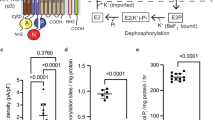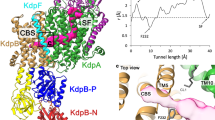Abstract
The Na+/K+ pump, a P-type ion-motive ATPase, exports three sodium ions and then imports two potassium ions in each transport cycle. Ions on one side of the membrane bind to sites within the protein and become temporarily occluded (trapped within the protein) before being released to the other side1,2, but details of these occlusion and de-occlusion transitions remain obscure for all P-type ATPases. If it is deprived of potassium ions, the Na+/K+ pump is restricted to sodium translocation steps3, at least one involving charge movement through the membrane's electric field4,5. Changes in membrane potential alter the rate of such electrogenic reactions and so shift the distribution of enzyme conformations. Here we use high-speed voltage jumps to initiate this redistribution and show that the resulting pre-steady-state charge movements relax in three identifiable phases, apparently reflecting de-occlusion and release of the three sodium ions. Reciprocal relationships among the sizes of these three charge components show that the three sodium ions are de-occluded and released to the extracellular solution one at a time, in a strict order.
This is a preview of subscription content, access via your institution
Access options
Subscribe to this journal
Receive 51 print issues and online access
$199.00 per year
only $3.90 per issue
Buy this article
- Purchase on Springer Link
- Instant access to full article PDF
Prices may be subject to local taxes which are calculated during checkout





Similar content being viewed by others
References
Post, R. L., Hegyvary, C. & Kume, S. Activation by adenosine triphosphate in the phosphorylation kinetics of sodium and potassium ion transport adenosine triphosphatase. J. Biol. Chem. 247, 6350–6540 (1972).
Beaugé, L. A. & Glynn, I. M. Occlusion of K ions in the unphosphorylated sodium pump. Nature 280 , 510–512 (1979).
Garraham, P. J. & Glynn, I. M. The behaviour of the sodium pump in red cells in the absence of external potassium J. Physiol. 192, 161–174 (1967).
Fendler, K., Grell, E., Haubs, M. & Bamberg, E. Pump currents generated by the purified Na+K+-ATPase from kidney on black lipid membranes. EMBO J. 4, 3079– 3085 (1985).
Nakao, M. & Gadsby, D. C. Voltage dependence of Na translocation by the Na/K pump. Nature 323, 628– 630 (1986).
Läiger., P. Electrogenic Ion Pumps (Sinauer, Sunderland, MA, 1991 ).
Gadsby, D. C., Rakowski, R. F. & De Weer, P. Extracellular access to the Na,K pump: pathway similar to ion channel. Science 260, 100– 103 (1993).
Hilgemann, D. W. Channel-like function of the Na,K pump probed at microsecond resolution in giant membrane patches. Science 263, 1429 –1432 (1994).
Heyse, S., Wuddel, I., Apell, H. J. & Sturmer, W. Partial reactions of the Na,K-ATPase: determination of rate constants. J. Gen. Physiol. 104, 197–240 ( 1994).
Rakowski, R. F., Gadsby, D. C. & De Weer, P. Stoichiometry and voltage-dependence of the sodium pump in voltage-clamped, internally-dialyzed squid giant axon. J. Gen. Physiol. 93, 903–941 ( 1989).
Läuger, P. & Apell, H. J. Transient behaviour of the Na+/K+-pump: microscopic analysis of nonstationary ion-translocation. Biochim. Biophys. Acta 944, 451–464 (1988).
Wuddel, I. & Apell, H. J. Electrogenicity of the sodium transport pathway in the Na,K-ATPase probed by charge-pulse experiments. Biophys. J. 69, 909–921 (1995).
Friedrich, T. & Nagel, G. Comparison of Na+/K+-ATPase pump currents activated by ATP concentration or voltage jumps. Biophys. J. 73, 186–194 (1997).
Forbush, B. Rapid release of 42K or 86Rb from two distinct transport sites on the Na,K-pump in the presence of Pi or vanadate. J. Biol. Chem. 262 , 11116–11127 (1987).
Inesi, G. Characterization of partial reactions in the catalytic and transport cycle of sarcoplasmic reticulum ATPase. J. Biol. Chem. 262 , 16338–16342 (1987).
Lu, C.-C. et al. Memtrane transport mechanisms probed by capacitance measurements with megahertz voltage clamp. Proc. Natl Acad. Sci. USA 92, 11220–11224 (1995).
Bezanilla, F., White, M. M. & Taylor, R. E. Gating currents associated with potassium channel activation. Nature 296, 657– 659 (1982).
Acknowledgements
This work was supported by grants from the NIH. M.H. was supported in part by the Grass Foundation, and J.W. held a HHMI Postdoctoral Research Fellowship for Physicians.
Author information
Authors and Affiliations
Corresponding author
Rights and permissions
About this article
Cite this article
Holmgren, M., Wagg, J., Bezanilla, F. et al. Three distinct and sequential steps in the release of sodium ions by the Na+/K+-ATPase. Nature 403, 898–901 (2000). https://doi.org/10.1038/35002599
Received:
Accepted:
Issue Date:
DOI: https://doi.org/10.1038/35002599
This article is cited by
-
The Na+,K+-ATPase and its stoichiometric ratio: some thermodynamic speculations
Biophysical Reviews (2023)
-
Structure and activation mechanism of the hexameric plasma membrane H+-ATPase
Nature Communications (2021)
-
Partial Reactions of the Na,K-ATPase: Determination of Activation Energies and an Approach to Mechanism
The Journal of Membrane Biology (2020)
-
The CAPOS mutation in ATP1A3 alters Na/K-ATPase function and results in auditory neuropathy which has implications for management
Human Genetics (2018)
-
Dynamics of P-type ATPase transport revealed by single-molecule FRET
Nature (2017)
Comments
By submitting a comment you agree to abide by our Terms and Community Guidelines. If you find something abusive or that does not comply with our terms or guidelines please flag it as inappropriate.



